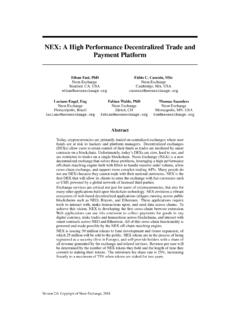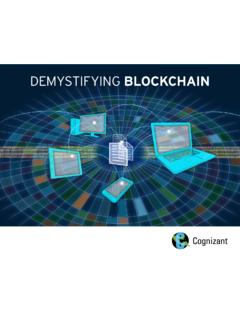Transcription of Orchid: Enabling Decentralized Network Formation and ...
1 Orchid: Enabling Decentralized Network Formation andProbabilistic Micro-PaymentsDavid L. Salamon, Gustav Simonsson, Jay Freeman, Brian J. Foxand Brian Vohaska with Stephen F. Bell, and Steven Waterhouse, 28, 2018 Version methods for censoring browsing and for discovering private browsing information have become moreeffective, the interest in anonymization methods has increased. Unfortunately, existing approaches tounrestricted, unsurveilled Internet access such as I2P and Tor suffer from a lack of widespread adop-tion.
2 Indeed, only a few thousand unpaid volunteers host relays and exit nodes, allowing sophisticatedattackers a tractable number of nodes to monitor or otherwise compromise. We present a market based,fully Decentralized , and anonymous peer-to-peer system based on bandwidth mining which we believeaddresses this lack of relay and exit nodes by directly incentivizing paper is written to describe a system still under development. As such, it will undoubtably changeand have new content added to address any implementation differences that arise; it is flexible in itsuse of library components and specific encryption algorithms.
3 However, the essence of the system, itspurpose and its goals will remain the include: A blockchain-based stochastic payment mechanism with transaction costs on the order of a packet A commodity specification for the sale of bandwidth A method for distributed inductive proofs in peer-to-peer systems which make Eclipse attacksarbitrarily difficult An efficient security-hardened auction mechanism suited for the sale of bandwidth in circumstanceswhere an attacker may alter their bid as part of an attack A fully distributed anonymous bandwidth market1 Contents1 Introduction42 Alternative
4 Approaches53 Attacks64 The Orchid Fundamental Market Operations .. Fundamental Peddler Operations .. Medallions on The Orchid Market .. Signed Routing and Eclipse Attacks .. Eclipse Attacks and Regeneration .. Finding Entry Nodes .. IdentifyingtheOrchid Market .. Proxy Whitelists ..135 Medallion Proof-of-Work .. Selection of Proof-Type .. Medallion Specification ..156 Orchid Payment Requirements .. Traditional Payments .. Blockchain Payments.
5 Blockchain-Based Probablistic Micropayments .. Orchid Payment Scheme .. The Orchid Token .. Orchid Gas Costs .. Censorship Resistance .. Balance of Trade .. Anonymity ..207 Bandwidth Mining218 Performance Scaling229 External Libraries2310 Future Work23A Appendix Overview .. Simplified Model for Analysis .. Selection Attacks .. Candidate Strategies .. Stability Analysis .. Economic Compatibility Analysis .. Conclusion ..32B Attacks and Collusion Attacks on Chains.
6 SSL and TLS Vulnerabilities .. Firewall Circumvention Features .. Attack Analysis and Attacker User Stories ..37C Medallion Engineering Specification39D Payment Protocol and Payment Ticket Cryptographic Choices .. Payment Ticket Definitions .. Payment Ticket Generation .. Payment Ticket Verification .. Claiming Payment from a Ticket ..42E Additional Payment How Much Will Packets Cost? .. Ethereum Transaction Costs .. Performance .. Building Micropayments from Macropayments.
7 Payment Channels .. Probabilistic Payments .. Further Orchid Token Details .. Verifiable Random Functions .. Non-interactive Payments Scheme ..48F Related Virtual Private Networks .. Peer-to-Peer Protocols .. Blockchain Platforms ..5131. IntroductionThe Orchid Protocol organizes bandwidth sellers into a structured peer-to-peer (P2P) Network termed theOrchid Market. Customers connect to the Orchid Market and pay bandwidth sellers in order to form aproxychainto a specific resource on the more common methods for sending and receiving data from the global Internet, proxy chains inthe Orchid Market naturally separate information about the source of data from information about itsdestination; no single relay or proxy holds both pieces of information, or knows the identity of someone whodoes.
8 The structure of the Orchid Market further supports this separation of information by providing strongresistance againstcollusion attacks the ability of a group of bandwidth sellers to overcome this separationof roles of the participants of a proxy chain are: sourcenode orcustomer the participant initiating a transaction. relaynode intermediary participants that forward Network traffic. proxyorexitnode participant that connects to a requested global Internet site. emphbandwidth seller less common methods for sending and receiving data from the global Internet, which do compartmen-talize source and destination knowledge, the Orchid Market providesfixed rate relayingto prevent trafficanalysis, and an incentive for participation not related to the hiding or discovery of information.
9 Paymentin we describe the details of the system, we will briefly review the core problems it solves, and thegeneral solutions we have chosen for our system s AnalysisProblemProblem Statement:Imagine you are in a cafeteria full of mathematicians and wish to send a messageto your friend across the room without anyone else knowing that fact. You have not already negotiated amessage passing protocol, so all implementation details must be publicly stated to everyone the room. Whatcan be done?A particularly elegant solution to this problem, proposed by Chaum in 1981[56], is to have every person actas both a relay and a recipient.
10 In this scheme, participants prepare encrypted messages which are the digitalequivalent of envelopes containing envelopes to send a message to Alice, you would computeEnc( T oBob ||Enc( T oAlice ||Enc(message, Alice), Bob), Carol)and send that message to Carol, who decrypts it and sends it to Bob, who decrypts it and sends it toAlice. To prevent traffic analysis everyone sends a fixed number of messages every cycle. To handle returnaddresses, we can have Bob and Carol remember a unique message identifier and send messages back alongthe particular importance to systems using the above method is the possibility of aCollusion.








